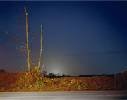Two exhibitions
dal 20/3/2007 al 3/5/2007
Segnalato da
Juan Araujo
Tobias Buche
Jeroen de Rijke
Willem de Rooij
Yaron Leshem
Michaela Meise
Barbara Visser
Gerard Byrne
Elena Crippa
Silvia Sgualdini
20/3/2007
Two exhibitions
Lisson Gallery, London
Gerard Byrne's work exploits the ambiguities inherent in historicising the legacy of cultural forms from theatre, to photography, or to magazines all of which have been accorded the role of representing society to itself. Construction Time Again presents works that reflect on issues of presentation and the production of images in the visually-oriented and image saturated culture of the 21st century.

Construction Time Again
curated by Elena Crippa and Silvia Sgualdini.
Juan Araujo, Tobias Buche, Jeroen de Rijke/Willem de Rooij, Yaron Leshem, Michaela Meise, Barbara Visser
Construction Time Again presents works that reflect on issues of presentation and the production of images in the visually-oriented and image saturated culture of the 21st century. The exhibition seeks to question the ideological implications of the image as a layering of historical, cultural and social systems and examines the way in which, as spectators, we approach, filter and interpret information.
There is no such thing as an image without fictions. As Jacques Rancière states: “the real must be fictionalized in order to be thought”. In Barbara Visser's Two Projections (2005), a static image of the artist's studio acts as a framing device for a slide projection showing images of modernist furniture. The focus oscillates between apparently insignificant details and overly meaningful imagery as an uncertain relationship is established between the narrative of early Modernism and the personal memories of Visser's grandmother, Miep van de Sleen-de Vries, who used to collect and design furniture for her own house.
De Rijke/De Rooij's slide projection Orange (2004) acknowledges a critical distance between the space of representation and that of reference. The reduction of the image to abstract shades of a single colour - significantly excluded from the spectrum of colour films because of the pink cast it produces on skin tones - is here associated with very specific political and social connotations, such as the colour of uniforms worn by prisoners at Guantanamo Bay or neo-conservative sympathizers for the House of Orange in Holland.
The works in Construction Time Again function by referring to and collapsing diverse visual registers and deferring meaning to what lies beyond the frame. Tobias Buche's complex arrangements of press cuttings, personal photographs and historical images invite a spatial way of looking. The images are physically related but loosely connected in a synchronic montage. The work counters the emphasis placed on the singular image with multiple narrative perspectives that accelerate and decelerate across the installation's spatial planes.
Juan Araujo's paintings and Yaron Leshem's photographic series Intrepid (2006) are charged with a palpable tension between the desire to represent, the awareness of visual stereotypes and the limits of the medium and how it has been used to express and translate reality into a visual output. Araujo's series of paintings Cuadros del Cerrito (2006) reproduce pages of catalogues and publications featuring Villa Planchart, built in Caracas between 1953 and 1958 by architect Gio Ponti. The features on the villa reflect a particular international vision and belief system, as much as the interest in design and collecting that dominated the prosperous Venezuelan upper class of the time.
Michaela Meise creates sculptures, which are formally indebted to minimalism. Pasted with photographic portraits of iconic figures such as Nico, the vocalist with the Velvet Underground or VALIE EXPORT, the structures become enigmatic physical extensions of the image into space and various narrative levels emerge from their delicate balancing act.
By elaborating physical structures and discursive constructions that blur the boundaries between the logics of fact and fiction, these works point to the conventions that define the procedures of power while actively opening up the potential of meaning contained in an image as something which is always incomplete and voiceless.
..................
Gerard Byrne
Gerard Byrne's work exploits the ambiguities inherent in historicising the legacy of cultural forms from theatre, to photography, or to magazines all of which have traditionally been accorded the role of representing society to itself.
The work is primarily lens based, in film, video, and photography. The photographic projects are generally characterised as historical site–related projects made over several years. The film / video projects involve reconstructing particular historically charged conversations originally published in popular magazines from the 1960’s -1980’s, with the intention of testing the cultural present of the gallery space against the present evoked in a magazine article from the recent past.
Finally, developing out of his conceptual interest in acting and theatre as cultural forms, Byrne has worked on a number of projects with actors and sets in gallery spaces which test the nominal historical distinctions between sculpture and set design, acting and non-acting, and spectacle and spectator.
Image: Gerard Byrne
Opening: 21 march 2007
Lisson Gallery
29 and 52-54 Bell Street - London
Free admission



